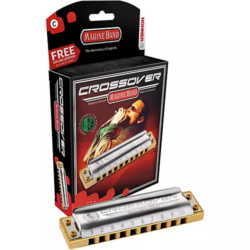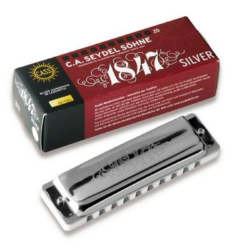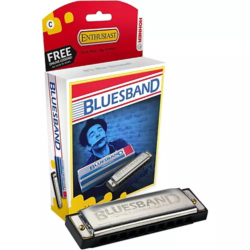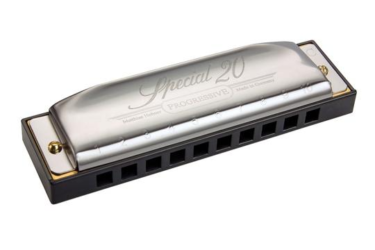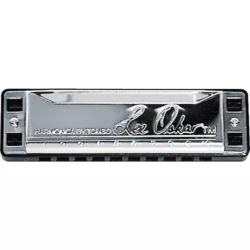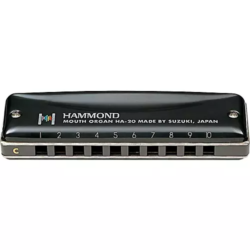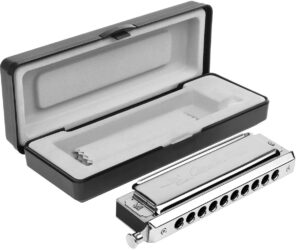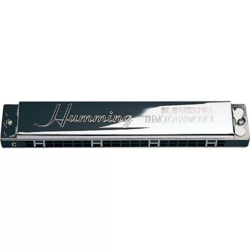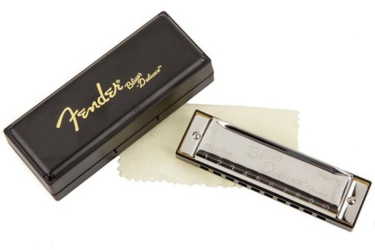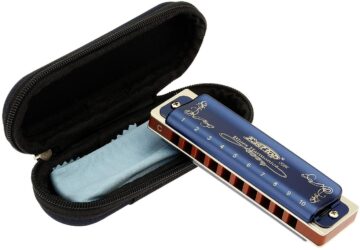There’s so much to like about harmonicas. The first thing that comes to mind is how portable they are. Anybody who’s played an instrument like the drums or upright bass knows what a boon that is.
Harmonicas are also more affordable than most musical instruments on average. They’re a great instrument for anyone looking to make an affordable entry into the world of music. And when you use them just right, they can serve as the perfect backup to a song’s melody thanks to their rich harmonizing abilities and understated intensity.
So in this article, we’re going to take a look at the best harmonicas that you can buy. But as you probably know, there isn’t one particular harmonica that is the right choice for everybody. In the first section, we’ll take a look at some of the basics of harmonicas and what you need to know before your purchase.
Then we’ll dive into our list of best harmonicas on the market in 2025, followed by our guide on how to get the most out of your instrument.
- Things to Know Before Buying a Harmonica
- Top 10 Best Harmonicas 2025
- 1. Best Overall Harmonica: Hohner Marine Band Crossover M2009
- 2. Best Premium Harmonica: Seydel 1847 Silver Diatonic Harmonica
- 3. Best Budget Harmonica: Hohner Blues Band
- 4. Best Beginner Harmonica: Hohner Special 20
- 5. Best Intermediate Harmonica: Lee Oskar Diatonic Harmonica
- 6. Best Compact Harmonica: Suzuki Promaster Hammond
- 7. Best Chromatic Harmonica: Eison Chromatic Harmonica
- 8. Best Tremolo Harmonica: Suzuki SU-21H
- 9. Best Blues Harmonica: Fender Blues Deluxe Harmonica
- 10. Best Design: East Top Diatonic Harmonica
- Frequently Asked Questions
- Everything You Need to Know About Harmonicas
- Time for Some Harmonica Fun
Things to Know Before Buying a Harmonica
The harmonica is a surprisingly simple instrument to get started with. You don’t need to concern yourself with too many configurations or specifications when you’re buying one of these. An important thing that you do need to keep an eye on is the type of harmonica you’re about to buy.
Types of Harmonicas
There are three commonly used types of harmonicas that every musician should know about. Our complete buying guide gives more information on these types, but for now, here’s an introduction to each.
Diatonic Harmonicas
Whether you’re looking at folk, blues, or pop music, the most popular type of harmonica you’ll encounter is the diatonic harmonica. This is why the majority of harmonicas coming up on our list are diatonic harmonicas.
These are harmonicas that can play notes only on one scale. So if you get a diatonic harmonica tuned to C, you can play notes only on the C scale. If you’re a beginner, all you need to know right now is that each diatonic harmonica plays only a single key in its standard form.
Chromatic Harmonicas
The Chromatic scale, for those new to music, is a scale that comprises all twelve pitches of the equal-tempered system in Western classical music. Harmonicas that can play the entire chromatic scale are known as chromatic harmonicas. So with these, you don’t have to worry about not being able to play certain notes of a key like you would on a diatonic harmonica.
Tremolo Harmonicas
When you hear the word tremolo, think trembling. It’s the effect in music where you rapidly play a note to make it sound like it’s trembling. Tremolo harmonicas achieve their trembling effect by employing a double-row arrangement of two reeds for every note. One reed is tuned to be under a particular reference pitch while the other is slightly over. In this way, it creates the effect of rapidly playing a note iteratively.
Important Parts of a Harmonica
Harmonicas may seem small, but they have complex constructions to make those mellifluous melodies possible. There are a few parts that you need to know about before buying your next harmonica.
Comb
The body of a harmonica, which includes the air chambers, is known as the comb. It’s called that because of the way in which the construction of the instrument resembles a hair comb. This part can be made from wood, plastic, or even metal, like the Suzuki Promaster Hammond.
Reeds
The reeds are the part of the harmonica that vibrates to the frequency of a particular note. These reeds are grouped into one section by the part of the harmonica called the reed plate. The reeds are usually connected to the reed plate using rivets. In certain cases, they may be screwed or welded into the reed plate.
Key Tuning
Harmonicas come tuned to a particular key. This is a little bit of an alien concept for those who have experience playing other musical instruments. If you’re a guitar or violin player, you’ve never heard of an instrument that comes tuned to just one key.
Harmonicas, however, do come tuned to particular keys. So now you’re wondering which note your harmonica should play. The answer, especially if you’re a beginner, is simple. Start at C.
Why? For starters, because it’s one of the most commonly used scales in music. Harmonicas tuned to C also have average length reeds, making them easy to play. Most harmonica instructionals assume you have an instrument tuned to C, so you’ll be able to follow along a lot more easily if that’s what you’ve got.
Once you’ve mastered the C harmonica, you can begin to diversify. The next step is to acquire harmonicas tuned to A, D, and G. A lot of blues, rock, and country is based on those scales. If you decide to go in the jazz direction instead, consider harmonicas tuned to Bb and F.
Number of Holes
If you’ve tried to buy a harmonica, you know that they can have anywhere from 8 to 24 holes. And if you’re a beginner, you’re probably wondering how many holes your starter harmonica should have.
A 10-hole diatonic harmonica is the best starting point for beginners. Like most other things in life, you want to start small and keep things simple. Once you’ve mastered the beginner harmonic, you can then move onto harmonicas with more holes.
With all that out of the way, let’s dive into our list of the best harmonicas money can buy in 2025.
Top 10 Best Harmonicas 2025
1. Best Overall Harmonica: Hohner Marine Band Crossover M2009
Why we like it:
The Hohner Marine Band Crossover is sensitive to fine changes in input and produces a rich, harmonic sound.
Quick Specs:
- Type:Diatonic
- Holes:10
- Reed plates:Brass; 0.9 mm
- Comb:Sealed bamboo
- Sample:Youtube
The Hohner Marine Band Crossover M2009 is a harmonica that benefits from the great attention to detail that’s been paid in constructing it.
It becomes evident very quickly that this harp is significantly more airtight than Hohner’s other products, which leads to two happy results. The first is that you can generate high volumes without wearing yourself out. Every harmonica player knows the importance of being able to rock out without feeling like your lungs are on fire.
The other consequence of the Crossover M2009’s efficiency is that it is responsive to subtle changes in input. You can change the amount of air you have going through the instrument or cup it a little differently and instantly make out a difference in the sound.
This harmonica is constructed using premium materials. It’s the kind of instrument you’ll probably enjoy just looking at because of the level of craftsmanship that has gone into it.
If you’re considering purchasing the Hohner Marine Band Crossover M2009, you should know that the holes on this harp are a little smaller and closer together than you’re probably used to. This can make it harder to target individual notes if you’re just starting out. For an easier experience as a beginner, check out the Hohner Special 20 harmonica.
Pros
- Extremely responsive to subtle inputs
- Well constructed
- Easy to play at high volumes without excess effort
Cons
- Holes positioned close to each other
Why we like it:
The Seydel 1847 may be a costly harmonica, but its stunning looks and high-quality construction make it a great buy.
Quick Specs:
- Type:Diatonic
- Holes:10
- Reed plates:Stainless steel
- Comb:Solid polymer
- Sample:Youtube
The Seydel 1847 Silver is a 10-hole diatonic harmonica. Nothing so special about that, right? Well, there’s more.
The reed plates on this baby are made using stainless steel. This isn’t the most common material that’s used to make reed plates; they’re usually constructed of bronze or brass. The advantage that you get with stainless steel is that it lasts a lot longer and also stays in tune longer. That’s a two-in-one that’s hard to overlook for harmonica players.
This instrument has a great sound thanks to the fine-cut reed plates used in the build. The plates minimize air loss and have you feeling like you can get the output you desire of it without too many theatrics.
It also helps that the Seydel 1847 Silver is easy on the eyes. This is a harmonica that’s very compact and has a beautiful silver exterior.
Now you will have to pay a pretty penny for the Seydel 1847 Silver. It isn’t the most affordable harp on the market, but you will get your money’s worth with this one.
Pros
- Durable stainless steel reed plates
- Minimal air loss
- An eyecatcher
Cons
- Relatively costly
3. Best Budget Harmonica: Hohner Blues Band
Why we like it:
The Hohner Blues Band punches well above its weight relative to its price tag.
Quick Specs:
- Type:Diatonic
- Holes:10
- Reed plates:Solid brass
- Comb:Plastic
- Sample:Youtube
Not every harmonica is meant to be played in an orchestra or in the studio. Some are made so you can whip them out quickly at a campfire jam and have a fun evening. If that’s what you’re looking for, the Hohner Blues Band is your best bet. This is a harmonica that’s so affordable that you feel like you can take those luxuries with it.
You will notice very quickly that this harmonica is priced significantly lower than most others. And that’s the idea. This is a Hohner harp that you can get at what feels like a throwaway price and still enjoy a decent sound.
Speaking of sound, the Hohner Blues Band provides a high quality of intonation and is easy to bend. You will be able to pull off some of the muting and vibrato effects that you expect from much higher priced harmonicas.
This is a budget product, though, and that comes with certain drawbacks. You will need to put in some effort to belt out loud notes on this instrument. It isn’t very airtight, so you will need to make up for that yourself. We explain how you can make a harmonica more airtight here. If you feel like you’ve cut your teeth enough on budget harmonicas like this one, check out the Lee Oskar Diatonic Harmonica.
Pros
- Very affordable
- High quality of intonation
- Easy to bend and mute
Cons
- Not very airtight
- Takes a lot of effort to play notes loud
4. Best Beginner Harmonica: Hohner Special 20
Why we like it:
There isn’t a better harmonica out there for beginners. The notes on the Hohner Special 20 are easy to hit and the flexible construction makes it easy to bend.
Quick Specs:
- Type:Diatonic
- Holes:10
- Reed plates:Brass
- Comb:ABS plastic
- Sample:Youtube
If you’ve asked around about harmonicas or researched them online, you’ve definitely heard of the Hohner Special 20. This is a harp that is beloved among the community for many reasons.
Perhaps the most important reason for its popularity is that this harmonica is extremely easy for beginners to use. The holes are spaced wide apart, making it easy to hit each note with precision. It’s also constructed in a way that makes it very easy to bend. That’s mostly thanks to the pliable plastic mouthpiece.
This harmonica’s body is built using stainless steel. Not only does it look stylish, but it’s also a very durable product. But you will need to open it up every now and then and clean it so that it lasts longer.
Not every harmonica player will enjoy the sound of the Hohner Special 20. The plastic comb is easy to bend, but the material leads to a sound that is a little tinny. The Suzuki Promaster Hammond harmonica is a good choice for those who want a diatonic harmonica that’s easy to play and also produces a beautiful sound.
Pros
- Easy for beginners to use
- Durable stainless steel body
- Easy to bend
Cons
- Can produce a tinny sound because of the plastic mouthpiece
5. Best Intermediate Harmonica: Lee Oskar Diatonic Harmonica
Why we like it:
This is a no-brainer choice for players beyond the beginner stages of harmonica playing who are looking to take their skills to the next level.
Quick Specs:
- Type:Diatonic
- Holes:10
- Reed plates:Stainless steel
- Comb:Plastic
- Sample:Youtube
We saw that the Hohner Special 20 is the best harmonica for beginners. But you won’t always remain a beginner, or at least that’s the hope. If you’re looking to get better, the Lee Oskar Diatonic harmonica is the next step in your progression as a musician.
This harmonica produces a bright sound that remains consistent no matter what variations you’re trying yourself. The high-quality sound is creditable to the way the reeds are positioned. There isn’t a lot of space between them, which means that there’s very little wasted air. This also means a sound that is projected very well.
The reed plates on the Lee Oskar Diatonic can be replaced easily. There are just three screws that attach the body of the harmonica to the reeds. That makes replacing the reeds a simple process. This contributes to the longevity of the instrument.
The Lee Oskar Diatonic harmonica is not the most affordable on the market. However, it is a great product for harmonica players who feel like they’ve mastered the basics and are ready for an instrument that matches their progressed skills.
Pros
- Good projection of sound
- Easy to replace reed plates
- Durable construction
Cons
- High price
6. Best Compact Harmonica: Suzuki Promaster Hammond
Why we like it:
The Suzuki Promaster Hammond is a fits-in-your pocket harmonica that you will enjoy as much for its sound as you will the workmanship that’s been put into it.
Quick Specs:
- Type:Diatonic
- Holes:10
- Reed plates:Bronze
- Comb:Aluminum
We all know that harmonicas are compact in general. But not all of them are so diminutive that you could actually carry them around in your pocket. It is nice, though, to walk around with the confidence that you have a harmonica on your person and you don’t need any extra accouterments to make that possible. That’s what the Suzuki Promaster Hammond makes possible.
Now be warned, if you do whip out this harmonica, the chances are that all the attention will shift to it very quickly. This is a beautifully crafted instrument that looks the part. The sleek black body and well-done typography make this instrument an eyecatcher.
But it isn’t all looks with the Suzuki Promaster Hammond. This is a harmonica that’s easy to play thanks to the ergonomics of the design. The instrument accommodates your lips perfectly, and you don’t have to worry about your mustache or beard getting caught in it.
You get a good quality of sound from this harmonica. The output may be a little light for some musicians’ preference. Because of the lightness of the sound, this may not work for someone who plays blues music, for example. Blues musicians should check out the Fender Blues Deluxe Harmonica instead.
Pros
- Very compact
- Great ergonomics
- Well designed
Cons
- Light sound
7. Best Chromatic Harmonica: Eison Chromatic Harmonica
Why we like it:
The Eison Chromatic Harmonica is the best sounding chromatic harp on the market and still remains an affordable option.
Quick Specs:
- Type:Chromatic
- Holes:10
- Reed plates:Copper
- Comb:Metal
We’ve finally got to the part of the article that all you chromatic harmonica players have been waiting for. This is known as the Eison Professional Chromatic Harmonica, but don’t let the name scare you. This harp is used by professionals, but it is just as accessible to students who take their harmonica learning seriously.
You will be hard-pressed to find a chromatic harmonica that sounds better than this one. The intonation on this instrument is incredible and leads to a sound that is beautifully rich. You really can use it to play just about any genre of music. What’s also great is that the Eison Chromatic Harmonica is easy on the pocket.
The one drawback of this instrument is in its design. The reed plate extends beyond the comb and has a jagged edge, which may make it hard to grip over long periods of time.
Pros
- Suitable for professionals and students alike
- Incredible quality of sound
- Affordable
Cons
- Protruding reed plate
8. Best Tremolo Harmonica: Suzuki SU-21H
Why we like it:
The Suzuki SU-21H tremolo harmonica is easy to play and produces a unique old-world tone.
Quick Specs:
- Type:Tremolo
- Holes:21
- Reed plates: Phosphor bronze
- Comb:Plastic
Tremolo harmonicas, as you’ll remember from our section about them, use a double-row arrangement to generate a distinctive sound. The Suzuki Suzuki SU-21H tremolo harmonica is often described as having an old-world sound, which means that it works great for music that feels like it has a bygone charm. Musicians often use it for old hymns, for example.
You will notice immediately that this harmonica is longer than the ones you’re used to if you haven’t played tremolo harmonicas before. This particular unit is about an inch and a half in excess of the average harmonica length. So it will be a little hard to carry around.
However, it’s worth the effort. The Suzuki SU-21H can hold a note without demanding too much effort from the musician. The design is gentle on your lips, and the reeds are very responsive to input.
Pros
- Unique sound
- Highly responsive
- Gentle on the lips
Cons
- Not the easiest to carry around
9. Best Blues Harmonica: Fender Blues Deluxe Harmonica
Why we like it:
The Fender Blues Deluxe Harmonica is the perfect instrument for those getting started playing the Blues.
Quick Specs:
- Type:Diatonic
- Holes:10
- Reed plates:Brass
- Comb:PVC
- Sample:Youtube
From Little Walter to Sonny Terry to Charlie Musselwhite, the blues tradition is rich with great harmonica players. So we had to include a harmonica built specifically for playing the blues. The Fender Blues Deluxe Harmonica is a great choice if you’re having a tryst with the blues.
This is the kind of harmonica that is especially suited for those just getting started with blues music. The design keeps things simple, and the instrument is easy to grip and maneuver. It comes with a vented case that makes it easy to keep it clean and dry after every use.
This Fender harmonica makes it very easy to produce notes. With other instruments, you may notice that only a certain number of notes are easy to play accurately. With the Fender Blues Deluxe, however, you can easily play all the notes right out of the box.
The sound of this harmonica may not be to your liking, especially if you’ve played blues music for a while. It can sometimes be a little low on brightness and volume. But if you’re looking to simply learn blues harmonica, it’s a great instrument to kick things off with.
Pros
- Easy to grip
- Comes with a case for protection
- Easy to accurately hit all notes
Cons
- Not very bright sound output
10. Best Design: East Top Diatonic Harmonica
Why we like it:
This is a beautiful looking harmonica that would make the perfect gift.
Quick Specs:
- Type:Diatonic
- Holes:10
- Reed plates:Phosphor bronze
- Comb:Plastic
The East Top Diatonic Harmonica is one that music teachers and professionals speak of highly. These harps are very affordable and produce a bright, lively sound. Some professionals may prefer to use this as a substitute harmonica, but beginners can also use it as their primary instrument.
This harmonica is a great looking instrument out of the box. The bright blue color and art on the casing make it easy on the eyes. This also means that it could be a great gift for someone just getting started out with the harmonica.
The East Top Diatonic punches above its weight relative to its price. The tone it produces is rich and it is a very airtight harp. It also has a heft to it, which some harmonica players like because of the control it gives them. You don’t want an instrument to feel flimsy in your hands ever.
The comb on this instrument is recessed to an extent. So you will have to adjust your lip pucker to account for that. This may mean having to take some time adjusting to the instrument, especially if you’re coming from a harmonica like the Hohner Special 20, which has a more conventional comb placement.
Pros
- Bright sound
- Beautiful design
- Nice heft to the instrument
Cons
- Recessed comb position may take some getting used to
Frequently Asked Questions
Here are our answers to the most frequently asked questions about harmonicas.
Harmonicas need to be cleaned regularly because of the way they’re used. This is to ensure that there is no buildup of saliva on the reeds and that the parts are working properly.
If your harmonica has alloy, plastic, or sealed combs, you can rinse it in lukewarm water. Have the mouthpiece facing downwards so that the water drains out once you’re done. If you have a harmonica that doesn’t have a sealed comb, then use a dry brush to clean it.
We saw that some harmonica are airtight and others not so much. If you have a harmonica that’s become less airtight, it will sound a little squeaky. You can, however, change that.
The process basically involves assembling your harmonica and putting it back together. You can find more information on how to do that here. When you put the harmonica back together, make sure that you tighten screws gradually and ensure that all the parts are packed in compactly. This will reduce the amount of air loss that happens in the harmonica.
It’s evident from our list that Hohner dominates that harmonica market. A lot of the best harmonicas are made by the company. But that doesn’t mean that you should limit yourself to Hohner products.
There are several companies out there that produce high-quality instruments. That includes Lee Oskar, Suzuki, Seydel, and Swan. Start by figuring out what kind of a harmonica you’re looking for, and then narrow your search down to a few popular brands in that niche.
The harmonica isn’t an instrument that demands a great deal of coordinative skill. When you learn the piano, for example, you have to be able to work your left and right hands independently. The drums require all of your limbs to work independently sometimes. The harmonica doesn’t require that kind of skill.
What you do need to know is how to switch between chords deftly and with the right timing. In that sense, learning the harmonica is a lot like learning to play the guitar. How long that process will take, like with anything else, depends on how much targeted practice you do. If you have experience with an instrument like the guitar, those skills transfer to the harmonica well.
Depending on who you ask, you will hear that harmonicas last only six months or 30 years. The reason you get that broad of a range is that harmonicas are simultaneously delicate instruments and hardy at the same time.
How long a harmonica lasts depends on how often you play it, how loudly, and how much moisture it is exposed to. If you don’t play it very often and very loud, your harmonica will last a very long time. But if you love playing it, that isn’t very practical.
So the best you can do for your instrument is to maintain it well. Clean it often, leave it out to dry often, and don’t let it rust.
Everything You Need to Know About Harmonicas
Now you’ve seen the best products available, let’s take a closer look at the different types of harmonicas available.
Diatonic Harmonicas
If you want to be able to play songs in every key, you will need twelve different harmonicas. It isn’t unusual for professional harmonica players to carry multiple harmonicas with them for this reason.
If you’re just starting out, it is best to buy a diatonic harmonica tuned to C. The functional advantage of doing so is that you won’t have to deal with any sharps or flats on the C scale. Additionally, most instructional materials produced for harmonica players use diatonic harmonicas on the key of C. Quite simply, they’re the most commonly used type of harmonica out there, whether that’s among beginners or professionals.
The Hohner Marine Band Crossover is an example of a popular diatonic harmonica.
Chromatic Harmonicas
To understand how chromatic harmonicas work, it helps to understand a little more about the chromatic scale. Each pitch in the chromatic scale is either a semitone above or a semitone below an adjacent pitch.
In their standard configuration, chromatic harmonicas play the notes in the diatonic scale for the key that they’re tuned to. If you want to play the other notes in that key’s scale, you need to pull on the sliding bar that’s on the instrument. This sharpens each note of the harmonica, thus allowing you to play a half step up from the standard configuration.
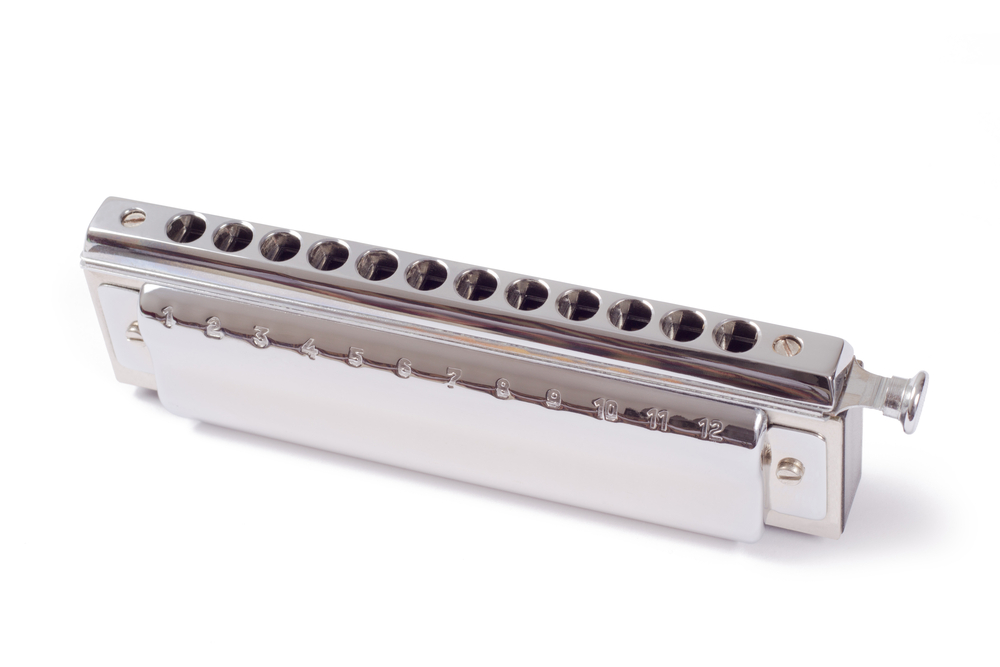
Just like diatonic harmonicas, chromatic harmonicas come in 12 different keys. But as we saw, these harmonicas can play every note because of the sliding bar built into them, so musicians usually use chromatic harmonicas tuned to C.
The Eison Chromatic Harmonica is a good choice if you’re looking for this kind of harmonica.
Tremolo Harmonicas
Tremolo harmonicas achieve their trembling effect by employing a double-row arrangement of two reeds for every note. On a guitar, you achieve this effect either by plucking at a note rapidly or by using the tremolo tailpiece attachment – popularly called a whammy bar – on electric guitars. If you want to pull the same effect off on a harmonica, you need what’s called a tremolo harmonica – one like the Suzuki SU-21H harmonica.
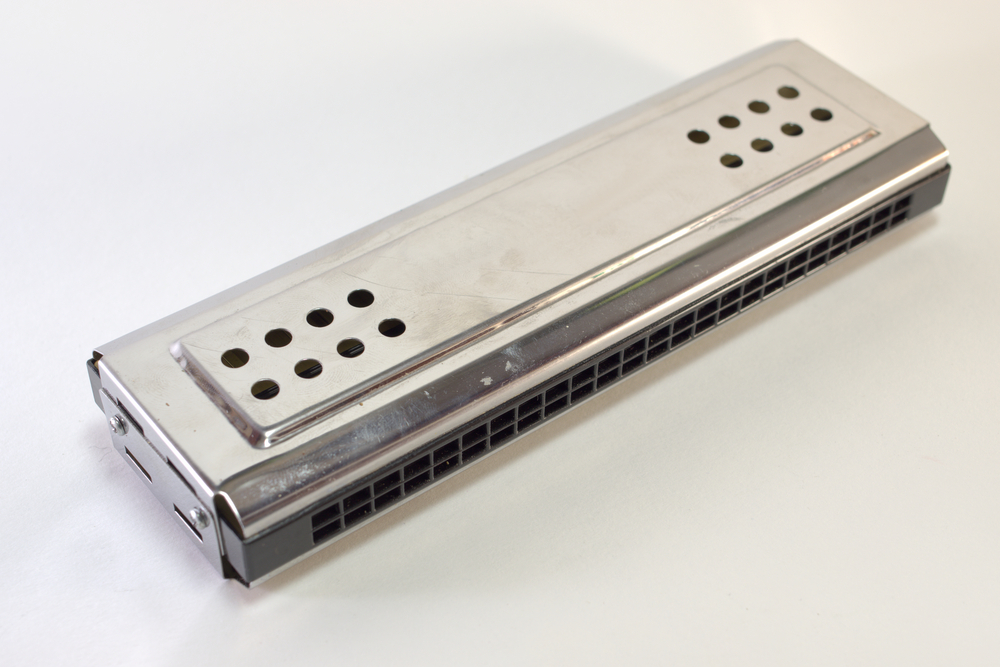
Now that we know the best harmonicas that are out there, it’s time to understand the instrument a little better. Making the right purchase is only the first step. You will want to understand the instrument well so you get the sound you want from it and can use it for a long time.
Understanding Harmonica Holes
Some harmonicas come with hole numbers printed above each hole. That can be helpful if you’re following along with an instructional book or video.
We go into more detail on our recommendation for a beginner harmonica within our review of the Hohner Special 20. But first, a quick explanation of the notes on a 10-hole diatonic harmonica.
The Notes of a 10-Hole Diatonic Harmonica
The notes that you play on a harmonica vary based on whether you’re blowing air into it or drawing air from it. On a 10-hole diatonic harmonica tuned to C on the Richter tuning, the following are the notes when you blow:
C E G C E G C E G C
The same harmonica, when air is drawn from it, has the following note order:
D G B D F A B D F A
That’s all you really need to know about the notes you can access on a 10-hole diatonic harmonica. Once you’ve mastered the beginner harmonica, you can move on to ones with more holes, which gives you access to more notes at a time.
How to Tune a Harmonica
Guitar players are used to having to tune their instruments all the time. Any stringed instrument responds drastically to small changes in temperature, tension, humidity, etc. Thankfully, the harmonica is not a stringed instrument, so you won’t have to tune it as often.
As we’ve already seen, harmonicas come tuned to a particular key. So if you have a harmonica tuned to C, it’s going to play on that key. Harmonicas don’t always maintain perfect tuning, however. Over time, your instrument can go slightly out of tune.
Unfortunately, it isn’t very easy to re-tune a harmonica yourself. The process involves opening up the instrument and chipping away at the reed to change its tuning. There’s more information on what the process looks like here.
Most harmonica players won’t be able to do all of that work themselves. So if your harmonica is out of tune, you can take it down to the local music store and have an expert look at it. If you have a budget harmonica that you’ve used for a long time, you could just consider purchasing another unit.
Amplifying a Harmonica
We saw in our product reviews that some harmonicas are louder than others. But you can’t always rely on the instrument’s innate projection to reach an audience. At some point, you will have to go electric. Today’s harmonica players have a lot of options to choose from when it comes to mics and amplifiers for the harmonica.
You’ve probably seen some harmonica players cup mics in their hands while playing. This gives them a level of control over the output that you can’t get playing into a mic that’s in a stand.
There are certain small mics that are perfect if you want to hold them in your hand along with your harmonica. Some are even designed specifically for harmonica players. The Nady VHM-7 Bushman Torpedo and Shaker Mad Dog are two compact microphones made for the harmonica.
When it comes to amplifiers, harmonica players usually use the same ones that guitar players do. So an amplifier like the Fender Super-Champ X2 should do the job if you’re looking to play a mid-sized room.
Time for Some Harmonica Fun
You now know everything needed to have a fun, enriching experience playing the harmonica. We hope that you can use this information to progress in your harmonica journey and entertain friends and family along the way. Happy playing!

